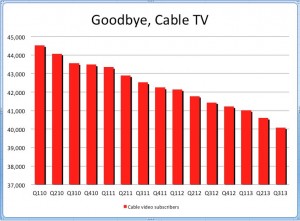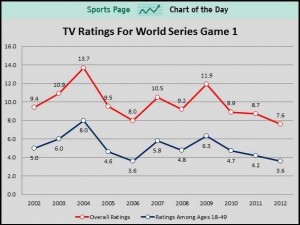Cable is dying; Welcome to the New TV
Long time no see, everyone. I know it’s been a while, but I’ve been really busy– mourning that PS3 took a lot out of me. Oh, I finally got a job, too, so that might have contributed to things.
Anyway, now that work is going smoothly, I was finally able to get a new PS3 last week (I even got most of my data back)! And so, now that I can play all my video games again, my topic for today is television.
With no games to play and a determination to be as unproductive as possible anyway, I ended up watching a lot of TV these past couple months. Not on an actual television, obviously. I mean, who does that nowadays?
No, really. Who nowadays regularly watches TV on an actual TV?
The classic scene of the family gathered in front of the television, balancing bowls of popcorn in their laps, racing to refill their drinks before the commercial break ends– this is something my parents described to me, but I’ve never experienced. I never grew up with cable TV. I had my video games, and that was good enough for me (of course, the drawback was being woefully ignorant of most popular culture, but I was a huge nerd anyway so it wasn’t much of an issue).
Families still watch TV together, of course. On Netflix. According to the Wall Street Journal, last year cable subscribers were paying an average of $54.92 a month just for basic service, and the price has most likely risen since then. An HBO subscription is $15 a month– $15 for one channel! Is getting the latest episode of Game of Thrones right away really worth that? (I don’t think so, but then, I’m not a fan.) Meanwhile, a Netflix streaming subscription is just $9 a month, lets you watch movies and TV shows whenever you want, and– best of all for all the impatient 20-somethings like me out there– is completely free of commercial breaks.

Oh yeah, and you can binge-watch TV shows. I have a policy to never start watching a show that’s still running, or at least wait until a significant backlog of episodes has been built up. Then I watch it all at once. You can’t do that with a regular cable subscription, where you’d have to wait for reruns. And wait a week or more between each episode. How do people do that?
The point I’m trying to make is that less and less people are buying cable and cable is dying, according to the internet hyperbole machine. Well, sites like Multichannel News don’t think so, claiming, “Television viewers aren’t going anywhere — they’re just demanding different digital services, and different ways of paying for the content they actually want to watch.”
Um, you mean like Netflix, right? Netflix and Hulu are what you’re talking about.
Anyway, I have some graphs to show you, because graphs make me look smart and like I know what I’m talking about. Here’s one from a 2013 Business Insider article, showing the drop in cable subscribers that’s been happening for the last few years.

Here’s another one, this time about the World Series. Which is for baseball, I think. I don’t understand all those acronyms and abbreviations. But basically, people are watching less sports on TV because livestreams exist.

But that article is two years old. So here’s something more recent from USA Today about people dropping their cable subscriptions, AKA”cord-cutting.” ” […C]ord-cutting accelerated during the first three months of a year, a sign that more consumers are dropping pay TV or sidestepping it altogether[,]” they write. So yeah, less and less people are buying cable, and more and more people are watching TV through alternative methods. And honestly, I think everyone’s happy except for the cable companies and the people who make commercials.
Most people “cutting the cord” are young adults, who never grew up with all that family-at-the-TV stuff and don’t see it as much of a loss. But don’t think this whole mess is just our fault. Trusting in the power of anecdotal evidence, I asked my Baby Boomer father which he’d prefer now: the traditional TV from his childhood, or his current Netflix subscription?
Dad immediately launched into a rant about commercial breaks that didn’t stop until I left the room. No, I don’t think the good old days were really that better.

Lynn Bachman was born and raised in Baltimore. After reading Lord of the Rings at a young age, she has had a perpetual fondness for fantasy worlds, epic quests and magical horses. When you can tear her away from her role-playing games, she enjoys such things as drawing, horseback riding, and of course, writing. Lynn received her B.A. in Writing and Literature from Juniata College in 2013. Don’t talk to her about sports or politics. Do ask to see her video game collection. [Steam: peacefulcascade; Playstation Network: pcascade;
3DS Friend Code: 2122-6206-0737]

While young people are least likely to have cable service, it’s a gross generalization to conclude that they comprise the bulk of cord cutters.
Do a little research and you’ll find that cord cutters run the gamut, and include even crusty old baby boomers like me. What makes some older viewers hesitant to end their cable service is that they’re simply unaware of all the great streaming options, and how to connect their TV sets to streaming services. I’ve shown my setup to a number of friends and seen a lightbulb go on in their brains.
Just a couple of things to clear up: HBO now has 8 channels, plus with the subscription you get On Demand and HBO.Go, both of which allow you to binge watch just about every HBO program, at least from the past 18 years (Sopranos and Sex and the City started in the late 90’s).
You can also get the “Go” feature from the cable provider, at no extra cost, which allows the subscriber to watch the programs on any device, no matter where they happen to be at the moment. That’s true with HBO.go and the other “pay” networks like Showtime. Plus, you don’t have commercials with HBO, Showtime, Encore, Sundance, etc. either.
But otherwise, I would say you are correct.